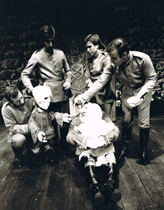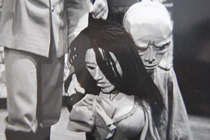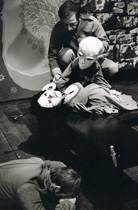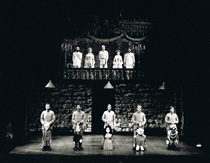 WOYZECK, 1974
WOYZECK, 1974
Texte de Georg Büchner
Concept et marionnettes : Felix Mirbt
Mise en scène : Felix Mirbt, Jean Herbiet
Décor : Michael Eagan
Créé en 1974 au Centre National des Arts d'Ottawa avec Jean Herbiet, Woyzeck a connu quatre versions. La seconde, après la création de 1974, est montée en 1976, Woyzeck II, toujours avec Jean Herbiet et au Centre National des Arts. Felix Mirbt monte une troisième version en 1988 au Centre Stage de Toronto, Woyzeck III, avec l'appui d'une une nouvelle conceptrice de décor et de costumes, Teresa Prsybylski. Enfin en 1993, une quatrième version voit le jour au Sir Wilfred Grenfell College à Terre-Neuve où Felix dirige les élèves de troisième année du département de théâtre.
Woyzeck est la deuxième collaboration entre Felix Mirbt et Jean Herbiet. Avec Le Songe, leur troisième création commune, Woyzeck est l'un des spectacles les plus marquants de la carrière de Felix.
Voici ci-dessous une sélection d'écrits de Felix Mirbt directement liés à la pièce Woyzeck ou en écho à son travail sur cette production, ainsi qu'un extrait de critique datant de la reprise de 1988.
The collaboration with Jean Herbiet continued. He invited me to the National Arts Centre to work on Woyzeck. (My initial reaction: since I had seen 8 or 9 Woyzecks in my life, why should I add another one)
WOYZECK 1 - August 29, 1992
I hated the idea. I had seen seven or eight different versions of Woyzeck back in Germany (films included). It was too close to my skin I guess and I reacted not too enthusiastically. Matter of fact, I resented it and it took Jean quite some convincing to get us going. To say the rest is history is almost right: I see Woyzeck as the point of before and after. And a lot of ideas started there to come out of hidden corners in myself. Somehow I did not see a particular future for me in all this and so took this occasion as my chance to do it as I always had wanted to do them: Go for it, totally. And when at some point I inquired about the budget, I was told very bluntly: you do your best and we look after the money. And I did. Some strange "instinct" klicked in. I knew what i had to do and it was not the amount of money that possibly could have been used but the total freedom and therefore "holy obligation" to follow a strangely exacting path. I can remember that moment still today. And during Woyzeck I realized, that that was exactly what I wanted to have done all my life. I was in the beginning of my forties. The original group of people I aimed for to work with was Harro Maskow, a personal friend, and people around him, who had just parted company with *** and were looking for work. But then they stuck to their own dream and became Theatre Beyond Words.
And after all these years I still find it difficult to separate Jean Herbiet's input. He very clearly provided a bouncing board for me, my ideas and my input. When we worked separately I remember it more as a division of labor than a division of ideas.
PROCÉDÉ
Je crée du théâtre avec des acteurs, des marionnettes et des objets.
Je veux ici clarifier les éléments qui font partie de mon processus de travail.
J’essaie de séparer le texte, les actions et les images pour pouvoir observer chacun d’eux en détail.
J’utilise :
Un acteur pour manipuler la marionnette
Un autre pour lire le texte
Je réalise que c’est mieux de :
Lire le texte comme si c’était une information au lieu de l’interpréter
Manipuler l’objet, le masque, la marionnette comme si c’était une indication
et non avec une motivation profonde
Utiliser la marionnette comme une icône
Plus on sépare les éléments clairement et franchement, plus on les rend indépendants,
(et par le fait même, interdépendants), et plus le résultat est fort.
Ça me fascine toujours autant.
WOYZECK (1974-93)
Georg Büchner
"A fragmentary work dating from 1836, which was far ahead of its time. Its characters speak simply and cynically; its (anti-) hero, Woyzeck, is an impoverished soldier and a naif who is baffled by the everyday corruption of life. The poor, he tells his captain, are too busy surviving to trouble about morality. When he discovers that his wife is promiscuous (a fact of which he alone was innocent), he is disoriented. Quietly, without any of the histrionics of romanticism, he murders her. The investigating judge, in a cackle of unfeelingness that has echoed down through Strindberg, Brecht and Beckett, declares it "a real good murder; we haven't had a good clean murder like this for a long time."
Visually the play has a strong element of german expressionism. The 25 scenes allow a continuous action interrupted only by visible scene changes. I separated VOICE from MANIPULATION in Inook. Here we went a step further and moved the VOICES on a balcony, the PERFORMER / MANIPULATORS and the puppets on stage below. And that created a very upsetting hierarchy: the gods, the messengers, the people: the authority came from the VOICES; the resentment, the anger from the MANIPULATORS expressed through the people (the PUPPETS).
From these separate(d) VOICES one hears a straight reading of the text, accompanied by bursts of emotion from the MANIPULATORS, whose work is sharply punctuated by military ritual and drill.
This military element carries through the whole production. From costume to hierarchy the Dukes and officers wear their uniforms and rank up on the balcony, the simple soldiers in the same uniforms as their puppets perform their duties on stage below.
Military drill laid out movement patterns for the manipulators and rules of how to handle the puppets, how to begin or end a scene, how to change the set between scenes. And I gave the performers three identities to constantly choose from: soldier / manipulator / the private persona.
WOYZECK II
In 1988 I explored the relationship of VOICES and PERFORMERS further and took a very different approach to the production. I put two women VOICES above five resenting male manipulator/performers. The two women VOICES, like angels of death, stand high above on cherry pickers and thus descend or elevate themselves whenever they like.
Here the military drill is not as defined anymore, and it reflects in the costumes: deserters, soldiers of fortune, mercenaries...(yet still angry as in the first version.)
"In this, his fifth staging of Woyzeck with puppets, Mirbt has worked with designer Teresa Przybylski to create a metallic world. Sheets of welded steel soar up the back wall of the theatre; blued metal, raggedly cut with a torch, laps over the edge of the stage. The puppet manipulators' boots clang down raucously on metal grids set in the stage. The two actresses who speak the puppet voices mount tyrannically overhead."
Ray Conlogue, The Globe and Mail, 18.11.88
IT IS MY DREAM TO PERFORM THE OPERA WOYZECK
AND THE PLAY WOYZECK ON THE SAME STAGE SIMULTANEOUSLY.
MILITARY [BOOT CAMP] DRILL #3 - August 16, 1992
In 1988 I restaged Woyzeck on Centre Stage in Toronto. Bill Glassco at that time could not be around and he tried hard to torpedo my "daring "ideas long distance. And again I wanted a drill instructor. They found us a German Herr von... who offered to teach us either American, British or German modern or German drill. He quickly stated his background, I mentioned Schulpforta, and er nahm selbst am Telephone Habt acht-Stel lung ein. He filled me in that at his (he was my age) time the students of Schulpforta marched at least once a week over to their (his) school (the name of which escapes me) to swim. It seemed to always involve at least one honorable scruff [wrestle]: "to make men out of us".
He also seemed to recall a "last stand" against the Russians by the younger kids of Pforta. I was never quite comfortable in his attitude toward me, looking up to me, even so he was taller. But perhaps it had to do with his wife, who was always present and had washed out blue eyes, which looked coldly at all the procedures.
BIONIC WOYZECK. - March 6, 1993
It happened during a production meeting for the second revival of Woyzeck. I had carelessly mentioned, half jokingly, how about an ending, where Woyzeck stands alone on stage, lifts one hand to his forehead and shakes his head in des-peration: we would have a second figure and inside of it, cuckoo clock like. You would drop a weight, which with a slowing down-governor, would simply lift the arm, head drops when arm reaches top position. Simple. Yeah, but someone from the IATSE crew (stagehands and carpenters) sat at the meeting and said: why not... and we could really do it, better then you would ever dream. Fate only knows why we gave in to let them work on it. It cost the production over thousand dollars and the entire shop of nine guys worked on it. The arm was lifted by a gadget that normally lifts the hood of a Cadillac car and it had a capacity of one-and-a-half ton. A motorcycle battery ran the whole operation and a micro-switch with 22 seconds delay operated the whole thing. And it weight 85 lbs.: I know, I had to carry it on two fingers (gently) onto the scene. The first time THAT Woyzeck appeared, the entire IATSE crew was present and they put it dead centre: THAT was the place for IT. I moved it over to the side, it took me quite a while to get used to it. Jean Herbiet freaked (because he was afraid to talk to the crew) and we both had plans of drowning it in the Rideau Canal late at night, just to get rid of it.
It became almost a stand-off with quite personal threats between me and them. I remember me explaining to them that it was not the decision of the director but ME personally they had to deal with. Well, it was never an easy truth and I came almost to blows with them, when on our tour in France two minutes before the Q Bionic was still in its packing box: but they made it on time with Bionic. Ultimately it was a great shtick and we got used to it, when in the final image Woyzeck stood alone, in a solo spotlight, left even by his last manipulator. Woyzecks hand rose slowly, exactly 22 seconds after I had thrown the mini-mini switch without batting an eyelash (where t'hell is the bloody switch again), his head turned slightly, than dropped into the hand, stayed there for a second, black-out. People loved it. So probably did we, the company. Eventually.




